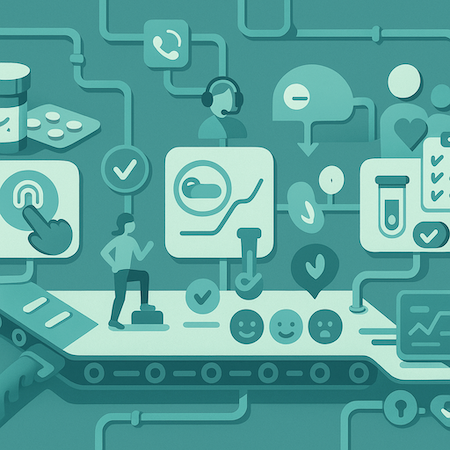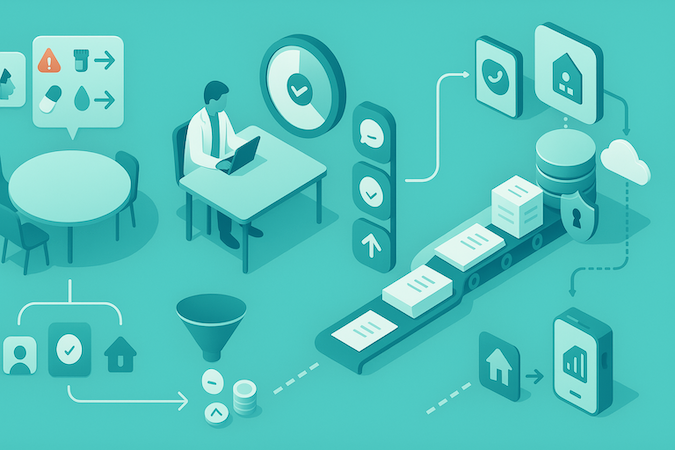How to Build a Habit Tracking App in 2026
Most “habit” apps collapse by week four. In healthcare, that cliff is fatal. Habit tracking app development isn’t about dopamine loops; it’s about care plans, billing, and audit trails that stand up in front of a clinician—and an auditor.
This guide is a field playbook for building a product that survives Monday mornings: pick a clinical-first data model, decide when “harmless” taps become PHI, wire into provider workflows, and use RPM/CPT rails to finance the work.
Let’s help you ship something clinicians trust and patients keep using.
Key Takeaways
- To create a habit tracking app that actually survives in clinics, build for clinicians first: PHI-safe architecture, provider dashboards, EHR pipes, and billable closed loops beat consumer streaks every time.
- Gamified habit tracker app development only works when the “game” serves clinical checkpoints—recovery after misses, titration milestones, documented actions—not vanity badges.
- Specode + its AI Builder let you start on HIPAA-ready rails, compose real workflows fast, and keep full code ownership—so you can ship in weeks, not quarters.
The 3-Day Cliff: Why Consumer Habit Apps Fail in Clinical Settings
If you build a habit tracker app for real patients, assume a cliff: the average app loses ~77% of daily actives by day 3 and ~90% by day 30 (Quettra/industry data via Andrew Chen). Category data confirms the drop—Health & Fitness average ~8.5% 30-day retention (OneSignal).
A consumer habit formation app might survive dopamine cycles; a care plan has titrations, side-effects, and prior auth. Different world, different physics.

“Many promising technological innovations in health and social care are characterized by nonadoption or abandonment … or failed attempts to scale up, spread, or sustain [them].”
— Trisha Greenhalgh et al., J Med Internet Research (NASSS).
Why Streak Counters Flop for Meds
Streak tracking punishes a miss; adherence needs recovery. In clinical life—delayed refills, symptom flares, competing appointments—a broken streak often ends the behavior. Evidence on gamification features in health is mixed (some gains, many modest or inconsistent), especially when designs ignore workload/capacity. Translation: points ≠ prescriptions.
The False Promise of Context-Free Gamification
Badges boost steps for a week; they don’t survive dose changes or care-plan rewrites. As Minimally Disruptive Medicine puts it, “Life gets in the way of healthcare. No one wants to spend their life being a patient.” Build for that reality: escalation paths, role-based access, and protocols that carry patients through setbacks.
What Actually Moves Retention
Use habit analytics to spot risk early (missed doses, symptom spikes) and trigger human touchpoints. Pair retention strategies with clinical scaffolding:
- protocolized follow-ups
- pharmacist callbacks
- refill automation
- documented recovery flows (what happens after a miss)
In fact, users with clinical conditions are up to 4× more likely to remain active than general users. Bake that advantage in with workflow integration—not just gamification features.
Three Business Models That Actually Generate Revenue

1. From D2C Fatigue to B2B2C with Providers
If you’re googling how to develop a habit tracking app, don’t copy consumer playbooks. D2C churn kills LTV. Sell outcomes through clinics and employers instead. When you reframe from productivity app development to clinical enablement, user engagement stops depending on hype and starts riding care plans, refill cycles, and supervision.
Translate consumer tactics—daily reminders, achievement badges, mobile app gamification—into clinically accountable moments (nurse outreach, refill sync, care-team dashboards). That’s how a habit formation tool gets budget, not just downloads.
2. Bill What Medicine Already Pays For: The CPT Route
If you want recurring revenue, align to reimbursement. Three codes consistently show up for tracking and reviewing patient-generated data:
- 99453: initial setup/education
- 99454: device supply/data transmission (per 30 days)
- 99091: collection/interpretation of physiologic data
2026 update: CMS added new RPM/RTM codes that pay for 2–15 days of transmitted data (and 10 minutes of treatment-management time), giving teams a reimbursable path for short-run monitoring. The existing 16-day codes remain, but the practical barrier for billing short bursts is gone.
Design the habit loop around clinical reality—cue-routine-reward becomes “protocol alert → patient action → clinician acknowledgement.” Wrap reminders with documentation and escalation paths; behavioral psychology still matters, but the unit of value is billed minutes and closed loops, not streak screenshots.
3. Enterprise Wellness: Where Distribution Lives
There’s a reason enterprise wellness is called the massive $60B+ market. It’s distribution and contracting power. Position your solution as risk-reduction (fewer sick days, better biometrics), not “morning routines made fun.”
Your habit formation app should ship with HRIS/SSO integration, population-level habit analytics, and privacy guardrails. Borrow from atomic habits thinking for copy and nudges—but promise program-level lift, not “inbox zero for step counts.”
Case Read: Consumer Calm vs Clinical Contracts
Headspace Health scaled consumer mindfulness; Omada Health scaled clinical contracting and outcomes. The lesson isn’t who’s bigger this quarter—it’s model fit. Consumer brands sell motivation; clinical brands sell risk management. If you want a durable play in healthcare, architect for care-team workflows first and sprinkle gamification second. Keep “fun” in service of follow-through, not the other way around.
The Architecture Decision That Determines Your Fate

Consumer-First vs Clinical-First Data Models
If you’re building habit tracking platform, decide this on day one. Consumer stacks model events (taps, streaks, badges). Clinical stacks model patients, episodes, care plans, orders, and audit trails—with versioned protocols and role-scoped visibility.
Your XP system can sit on top as a derived view; it should never be the source of truth. In goal tracking app development, bind “goals” to orders/diagnoses and store outcome evidence:
- time-stamped confirmations
- notes
- device readings
Minimal rule: if it must be charted or billed, it’s a first-class entity, not a gamified afterthought.
When Habit Data Becomes PHI
A “harmless” streak becomes PHI the moment it links to an identifiable patient, a diagnosis, or is accessible to a care team.
Treat push notifications as potential PHI (avoid exposing conditions on lock screens), and design for offline functionality without leaking data—encrypt at rest, require re-auth after idle, and queue data synchronization with signed, auditable envelopes.
Cloud backup is mandatory, but only with BAAs and lifecycle policies:
- retention
- deletion
- legal hold
Quick gut-check: if a screenshot could embarrass a patient, assume PHI and architect accordingly.
The Provider Dashboard Nobody Plans—Until Series A
Clinical outcomes die in inboxes. Ship a real back office: exception queues (who needs outreach today), protocol controls (cadence, thresholds), and one-click documentation to the chart. Make it multi-tenant, role-based, and defensible in audit (who saw what, who did what, when).
Two rails only: “work to be done” and “work just completed.” Everything else is reporting.
Integration Points: EHRs, Billing, Population Health
Design as if integration is day zero, not a future sprint. Map patient, encounter, observation, and task objects to FHIR early; isolate billing events so CPT/RTM changes don’t break your core model; and emit contract-friendly aggregates for population health.
Keep your mobile clients thin; do orchestration server-side to simplify cross-platform development and deterministic data synchronization with EHRs and claim systems.
Non-negotiables: idempotent webhooks, retryable jobs, and dead-letter queues; test against sandbox drift.
Bottom line: Architect for clinicians first, gamify second. If your model can survive audits, outages, and evolving CPT rules—and still deliver a clean provider queue—you’ve already won the hard part.
Core Features That Matter for Healthcare Habits

Medication Adherence: From Reminders to Recovery Paths
Reminders are table stakes; the win is a miss → recover workflow. Capture reasons for lapses, auto-reschedule, and route edge cases to a human. Ground flows in real behavioral patterns (refill cycles, side-effects, prior-auth delays), not idealized streaks.
If you insist on a leveling system, tie “levels” to clinical milestones (titration complete, labs on time), not vanity streak counts.
- Required: hold-to-confirm dose, late-dose logic, pharmacist callback triggers.
- Evidence trail: timestamped confirmations + notes for the chart.
PT Compliance That Measures What Matters
PT isn’t generic fitness app development. Track form, range of motion, tempo, and pain scores—then adapt plans around what the body can actually do. Small wins compound fitness habits; build progression that respects soreness and flare-ups.
- Inputs: camera-based form checks or sensor prompts; simple “good/needs work” feedback.
- Outputs: clinician-visible adherence + form quality, not just reps.
Diet → Glucose → A1C: Close the Loop
Food logs without feedback are busywork. Map meals to glucose response and A1C targets; surface patterns (late-night carbs, weekend spikes) and prescribe tiny swaps patients can actually keep.
- Fast capture: photo-first meal logging with carb tagging.
- Fast feedback: “next-meal guidance” that learns from the last week.
Mental Health Check-ins With Real Escalation
Short, scheduled mood/energy prompts feed triage rules; PHQ-9/GAD-7 on cadence; warm-hand-offs when thresholds are crossed. Complement with sleep tracking and meditation tracking as optional modules—they’re useful signals and low-friction wins but shouldn’t gate care.
- Green/yellow/red rules route to self-care, asynchronous messaging, or live outreach.
- Make every alert “actionable or silent”—no noisy purgatory.
The Caregiver Loop Everyone Forgets
Care plans fail alone. Add caregiver roles with consented visibility, shared tasks, and fallback reminders. Keep the tone supportive: nudge caregivers to coach, not police; let them request help or pause goals during life events.
- Controls: scoped permissions, quiet hours, and a “snooze care plan” switch.
- Receipts: audit who saw what and who did what—protect trust and the chart.
Design mantra: make core flows boringly reliable; save flair for later. Get the meds taken, the exercises done (safely), the meals logged with feedback, the check-ins routed, and the caregivers engaged. The rest can wait.
Advanced Features That Drive Clinical Outcomes

Predict the Miss Before It Happens
Use machine learning on adherence, symptoms, and context to flag patients trending toward a lapse. Surface AI recommendations as short, explainable next steps with personalized insights (“switch to morning dosing; align with commute”).
Treat this as a behavioral tracking app capability, not a crystal ball—always pair predictions with an accountable action. Show risk over time with concise progress visualization (traffic-light trendlines, not noisy charts).
SDoH-Aware, Not One-Size-Fits-All
Adaptive playbooks should pivot by transportation, food access, work shifts, and caregiver availability—real life, not ideals. Group goals by habit categories (meds, movement, sleep, nutrition) and flex interventions:
- delivery options
- clinic rides
- weekend-only plans
Lean on community features and social accountability for patients who benefit from peer nudges or sponsor-style check-ins.
Provider-Adjustable Reinforcement Schedules
Give clinicians dials: cadence, thresholds, and what happens after a miss. Rewards and prompts shouldn’t be fixed; they should adapt by diagnosis and phase of care. Tie “progress” to outcomes, not vanity numbers.
- Replace generic productivity metrics with clinical ones (titration complete, refill on time) and keep habit tracking app features aligned to those targets.
Integrate the Edge: RPM as Habit Fuel
Plug in CGMs, BP cuffs, scales, inhaler sensors—and make each reading a coaching moment, not a data flood. Small, specific nudges win (e.g., “pre-walk before dinner”), and yes, basic water intake tracking still matters for kidney, BP, and migraine cohorts.
- Device events trigger human workflows first; dashboards second.
Population Health Analytics for Value-Based Contracts
Roll patient-level signals into contract-level lift: rising-risk cohorts, cost-of-care deltas, and adherence heatmaps by clinic or program. Keep the story tight: which interventions moved which groups, how fast, and at what cost.
- Close the loop with roll-up progress visualization that payers and execs can read in one slide.
If you’re planning to develop a habit tracking application, bake in prediction, adaptation, clinician control, device context, and population roll-ups from day one.
Use AI recommendations and personalized insights to guide behavior, but let care plans—and the humans running them—own the final mile.
The Behavioral Economics of Healthcare Habits

Incentives That Don’t Backfire
Cash giveaways juice downloads; clinics need documented actions. Tie rewards to verifiable milestones (refills on time, dose titration completed) and log them to the chart. Use milestone rewards that unlock practical help (e.g., pharmacist consults) rather than gift cards.
Reflect gains in a habit calendar and simple progress charts so patients see what they’d lose by slipping.
Frame for Loss Aversion, Not Badges
People fight harder to avoid losing progress than to earn a trinket. Copy, visuals, and flows should emphasize “keep your stabilized dose/A1C trend” over “earn another badge.”
Cohort-Bounded Social Proof
Global leaderboards are noise; patient cohorts are signal. Show habit statistics relative to similar patients (same condition/phase), with respectful privacy defaults. Add soft social accountability options—peer nudges, sponsor-style check-ins—only where they help, never shame.
The Digital “White Coat”
Harness the appointment halo.
- Pre-visit: a two-minute prep (med list confirm, symptom snapshot).
- Post-visit (24–72h): one decisive task that locks the new plan (dose timing, PT routine).
For tough days, offer evening micro-wins that fit evening routines—short walks, breathing drills—so momentum survives real life.
Nudge Timing Around Clinical Events
Schedule push notifications around booked encounters, lab windows, and refill cycles—not arbitrary times. Use light time tracking for home tasks (10-minute PT sets, meal logging blocks) to keep asks finite and doable.
Rule of thumb: clinical clocks first, personal clocks second.
A practical habit tracking app development guide boils down to five levers: design for documented actions, protect prior gains, keep social proof within cohorts, exploit the appointment halo, and time nudges to care events. That’s how you turn behavioral economics into durable patient follow-through.
Building for Real Healthcare Workflows

Wire Into the Morning Huddle
Your app should show up where work starts. Feed the huddle with a single, prioritized queue: missed meds with safety risk, PT non-responders, rising glucose, unresolved flags from yesterday. Include reason codes and the next best action so the team can assign, not discuss.
Asynchronous Review That Actually Fits a Clinic Day
Design for short, predictable blocks—review in 10–15 minute bursts between visits. Pre-sort by risk and payer program, then ship one-tap dispositions (resolve, message, escalate). A lightweight Pomodoro timer can help teams stay focused without drowning in charts.
Batch Documentation for Billing
Every intervention should generate compliant artifacts automatically—then let clinicians batch-sign.
- Map interventions to billable events (99453/99454/99091/RTM) with auto-filled time and context.
- Produce a concise note, audit trail (who/when/what), and patient-visible summary in one click.
- Lock it to the encounter and export to the EHR without retyping.
Alert Fatigue: Stop the Pager Spam
Default to “actionable or silent.” Suppress duplicates, add recovery windows after outreach, and ladder escalation (nudge → async message → call → visit). Let providers tune thresholds by diagnosis/phase; show alert provenance so trust stays high.
Patient Portal vs Standalone App (Pick Your Battles)
- Portal add-on: Faster trust and identity, easier data exchange, but you inherit portal UX and release cadence.
- Standalone: Full control over wellness tracking modules and patient growth, but you must solve identity, messaging, and consent cleanly.
Whichever you choose, keep a thin mobile client and do orchestration server-side to make downstream integration boring.
Treat workflow as your primary feature. In custom habit tracker app development, your competitive edge isn’t bells and whistles—it’s predictable queues, clean async review, zero-drama documentation, and alerts that respect clinician attention. Everything else (badges, graphs, even the fanciest nudges) exists to make that machinery run smoother.
Cost Reality Check: Consumer vs Clinical Development
There isn’t a single habit tracker app development cost—there’s a staircase. Budget in stages: consumer prototype ($75–150K) → HIPAA foundation (+$50K) → first EHR integration ($25–100K) → initial clinical evidence ($100–500K). The only wrong number is a single sticker price that ignores the parts that make it clinical.
Base Consumer App — $75K–150K
What you get: cross-platform UI, auth, push notifications, basic analytics, streaks/badges, and lightweight content. What you don’t: HIPAA posture, audit trails, clinical dashboards, or EHR pipes. Good for proving UX only.
HIPAA-Compliant Foundation — +$50K minimum
Add role-based access, PHI encryption/key mgmt, audit logging, data lifecycle policies, breach/IR runbooks, secure cloud backup, and BAAs. Expect extra time for threat modeling and compliance evidence. This is the minimum to move from “cool app” to “clinic-ready.”
EHR Integration — $25K–100K per system
Drivers: vendor (FHIR vs HL7 v2), SMART app vs standalone, sandbox/provisioning gates, version drift, rate limits, and certification/testing. Budget both build and keep-alive (change windows, re-tests, and endpoint churn).
Clinical Validation Studies — $100K–500K
Protocol design, IRB, recruitment/retention, data operations, and analysis. Lower if observational; higher for multi-site or device-assisted trials. This is the price of evidence patients, providers, and payers will trust.
Hidden Costs You’ll Feel Later
- Compliance audits: SOC 2 / pen tests, periodic re-attestation.
- Provider training: playbooks, lunch-and-learns, super-user time.
- Interoperability testing: failover, idempotency, and message-order edge cases.
- Ops ramp: monitoring, on-call, SLAs, and incident drills.
Planning tip: Treat these as stackable increments, not surprises. A consumer prototype at ~$100K becomes a clinic-grade product only after you add the HIPAA layer (+$50K), your first EHR pipe ($25K–100K), and the initial validation work ($100K–500K).
How Specode Helps Healthcare Organizations Launch Habit Tracking
You don’t need a six-figure check to start. Spin up the AI Builder for free, compose real clinical flows, and when you’re ready to ship, choose a plan starting at $500/month—or a custom engagement from $5K/month if you need advanced integrations, AI agents, or hands-on build support. Most teams go from first prompt to a working app in weeks.

Start on HIPAA-Ready Rails
Specode opens to a functioning healthcare foundation—auth & roles, PHI-safe defaults, audit logs, patient/provider/admin portals—so your first sprint goes to clinical fit, not boilerplate.
Habit & Outcomes Toolkit, Not Vanity Streaks
Ship real behavior change with Goal Tracking, Symptom Tracker, Vitals, Notifications (HIPAA-safe templates), Scheduling, and Resources. These are designed for clinician-visible progress and auditability, not just badges.
Built for the People Doing the Work
Out of the box you get dashboards for providers and patients and a lean basic EMR (problems, meds, allergies, SOAP, immutable audit trail). That means exception-driven workflows, chart-ready artifacts, and role-scoped visibility from day one—exactly what keeps adherence programs alive past kickoff.
Integration Stance That Won’t Paint You Into a Corner
Specode takes a pragmatic path on pipes: Canvas Medical is supported case-by-case; Epic/Oracle Health/others via custom or middleware; eRx/labs/wearables through partners. You get a clear route to production integrations without the “all-inclusive” hand-wave.
Assembly Speed—With Guardrails
Teams can move up to 10× faster than hand-coding, while staying inside HIPAA-friendly patterns. When you outgrow presets, drop to code and keep iterating—no walled garden, no lock-in.
AI Builder: Build by Conversation, See It Now
Specode’s assistant turns plain-English asks into working screens and flows with an instant preview—so you shape behaviors before you ship code. It starts on a healthcare foundation (roles, workflows, audit trails) and lets you keep engineering in the loop when you need to go deeper.
- Connect your own data early: point the assistant at your schemas so UI and flows reflect real entities (care plans, encounters, meds).
- Guardrails: Change log restore, role-scoped testing, and a visible progress indicator keep experiments safe and reviewable.
- Integrations when you’re ready: EHR/EMR, labs, pharmacy, insurance, and custom APIs—the builder scaffolds the pipes, engineers finalize.
- No lock-in: export full code anytime and continue with your team (or ours) without rewriting what already works.
- Pragmatic vibe: “no AI magic—sequence and focus.” Modify packaged components; add only what’s net-new.
If you’re mapping how to make a habit tracker app for clinical use, Specode’s pitch is simple: start from a working, HIPAA-aware app; compose tracking, dashboards, and messaging components with the AI builder; integrate where it matters; and keep the code.
Instead of reinventing healthcare plumbing, focus your limited cycles on the workflows, cohorts, and interventions that move outcomes. That’s how to make a habit tracker app that survives real clinics—without betting your runway on scaffolding.
Start building in Specode’s AI Builder—free to try, HIPAA-ready by design, and typically shipping in weeks.
Frequently asked questions
Clinical fit beats consumer flair: use a clinical-first data model (patients, care plans, audit trails), wire into provider workflows (morning huddles, async review, batch documentation), and make every alert “actionable or silent.” Add recovery paths for misses, caregiver loops, and EHR/RPM pipes so behaviors map to documented actions and billing.
Treat cost as a staircase: consumer prototype $75K–150K; +$50K for HIPAA foundation; $25K–100K per EHR integration; $100K–500K for initial clinical validation, plus audits, training, and interoperability testing. “Fun” features don’t change the math—clinical readiness does.
Keep clients thin and do orchestration server-side; design for deterministic data sync, idempotent webhooks, retryable jobs, and dead-letter queues. Model to FHIR early, secure PHI (encryption, role-based access, audit logs), and prefer patterns that make EHR/claims integration boring and repeatable.
Use AI to predict non-compliance, tailor interventions by SDoH, and present explainable next steps that route into accountable human workflows (escalations, callbacks). Pair predictions with clinician dials (cadence/thresholds) and device context; show risk via simple progress visuals, not noisy charts.
Sell through providers/employers (B2B2C), align to reimbursable RPM/RTM work (e.g., 99453, 99454, 99091), and target enterprise wellness contracts. Note the 2026 update enabling billing for 2–15 days of transmitted data and a 10-minute management option—expanding billable scenarios beyond the legacy 16-day requirement.









